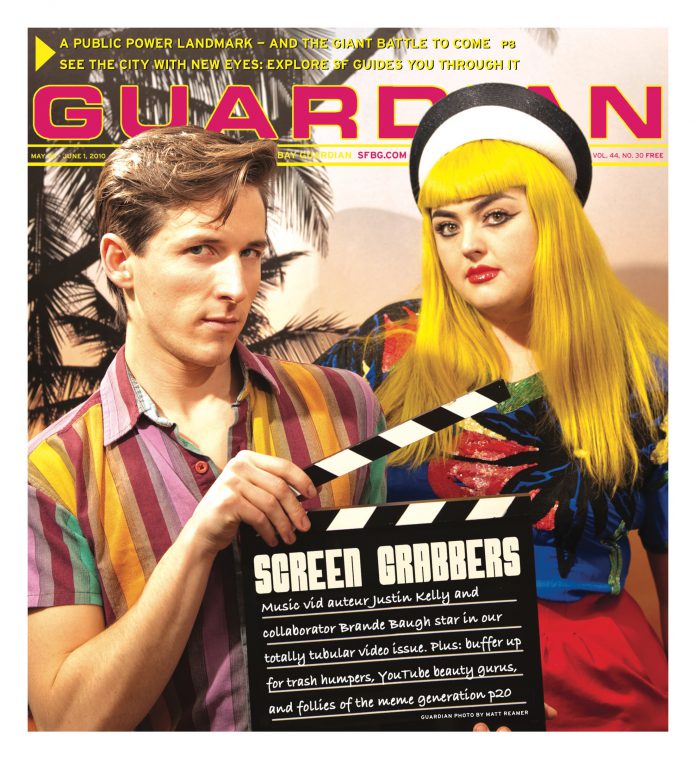arts@sfbg.com
FILM The wind blowing through the California Palace of the Legion of Honor courtyard would chill ordinary mortals to the bone on this Monday morning in early May. The museum is locked tight but the organ music that keeps wafting through its majestic outdoor columns seems oddly appropriate to the cavorting of two very slender, bare-chested young males and the object of their teasing attention, a spectacularly adorned ballerina. San Francisco Ballet dancers Jaime Garcia Castilla and Martyn Garside, and Trannyshack favorite Matthew Simmons, a.k.a. Peggy L’Eggs, apparently don’t mind a bit of physical hardship in the service of dance. They are the stars of Paul Festa’s new film, The Glitter Emergency.
Commissioned by ODC Theater, Glitter is the centerpiece of Festa’s full-length theater work, The Violin Show which will premiere in fall 2011. Right now on this gray day, the trio — with SFB dancer Myles Thatcher acting as choreographer — is dancing to music that only Festa hears.
He has had the score, Tchaikovsky’s Violin Concerto in D Major, inside his head every since he first heard it as a teenager. Planning a career as a concert violinist, he started to play it at 15. “It’s music I always thought should be a ballet,” he explains in a phone interview from his home in San Francisco. To his ears it sounded like leftovers of some ballet music. Considering that the Concerto was written in 1878, one year after Swan Lake, that is not a surprise.
Growing up gay in the 1980s when there was a “huge closet door” in the way of role models, Festa was always latching on to historical figures who might have been or were rumored to be gay. So the Tchaikovsky concerto was a natural match. He remembers the first movement, in particular as “so extremely joyous, so over the top, so excessively pushing boundaries” that to him it overflowed into camp.
Drawing on his experience performing at the Trannyshack, he decided to perform at least part of the score in drag, pretending to lip-synch the music while actually playing it live. He tried it a few times but it didn’t work. For one thing, Festa remembers, “it’s very difficult to act and play the violin at the same time.” But he also found that, though he could make fun of something that he also deeply loves — an essential ingredient to contemporary drag — he himself could not physically embody that experience. “What I needed,” he explained, “was a drag queen.”
He found her in Peggy L’Eggs; a few years ago, he had accompanied her in a one-legged, roller-skating rendition of Fokine’s Dying Swan. She became Peg-Leg Ballerina, Glitter‘s Cinderella who desperately wants to become a dancer but whose dream seems unrealizable because of a substantial physical handicap. Two evil stepsisters (Rumi Missabu of the Cockettes and Eric Glaser) hold the poor thing captive until the arrival of superhero Stringendo (Festa on live violin) and his two pixie assistants.
It’s not by chance that Festa went into the world of ballet for this parable about hope and transformation. Ballet has long resonated in queer culture, probably in part because of its presentation of an “unnatural,” aestheticized, and idealized body — female and male. In many ways ballet is an absurd art. It shouldn’t be possible. Additionally, it embraces giving pleasure as an end in itself. In some eyes, this makes the art intellectually suspect, unlike modern dance, for instance, which supposedly deals with weightier, more substantial issues regarding the human condition. But for those outside accepted norms of being, ballet can be welcoming.
Since he is comfortable in both worlds, Festa structured his 20-minute ballet film as “a mashup between silent film and music video.” Growing up in San Francisco, he remembers every Friday night going to the Avenue Theater for its double bills of silent movies with live accompaniment. Interestingly, he thinks that silent film may be making something of a comeback, in part because of the work of Lady Gaga.
Though Glitter shimmers with rhinestones, confetti, and silliness, like a lot of ballets, its heartbeat is steady and strong. “Do not turn away from the magic inside you,” exhorts one of the film’s copiously strewn-about subtitles to which our Cinderella responds with the longest batting eyelashes ever seen on a would-be princess. It’s a lesson she will apply when she finally meets her “better” self (SFB dancer Sylvie Volosov).
It’s also a lesson Festa himself had to learn. And he too had a mentor. While still at Juilliard, focusing on becoming a concert violinist, he developed a hand ailment that stopped a budding performance career in music. At the same time, he entered a 15-year long friendship with one of his professors, Albert Fuller, a pioneer in advocating the use of original instruments, who also taught performance practice at Juilliard.
“He and I used to sit at his bar for hours late into the night and listen to music and he would narrate his theater of the imagination.” A Schubert quartet would become a dramatic opera, a Poulenc organ concerto a horror film, and an old washerwoman would dance to Bach. But Fuller also taught him how to live his life. “He had a mantra that he kept repeating: ‘fantasy comes before fact.’ ” It may take a wise old professor or an outrageously silver-clad violinist in seven-inch platform shoes to turn dreams into reality, but as Festa’s Glitter attempts to show, it can be done. And we can laugh all the way through the journey.
Glitter will be shown with Festa’s homage to Fuller, Apparition of the Eternal Church (full disclosure: I have family members who appear in Apparition), a film inspired by Olivier Messiaen’s music.
THE GLITTER EMERGENCY AND APPARITION OF THE ETERNAL CHURCH
Thurs/27, 8 p.m., $10
Supperclub
657 Harrison, SF

